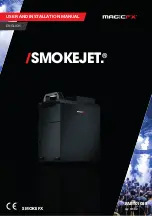
11 |
P a g e
CHOOSING THE CORRECT LIQUID FLOW RATE (CONT
/
D)
USING ENGLISH SYSTEM UNITS:
(BASED ON A 15 MINUTE FLOW TEST)
Output in pounds/h______ = output in U.S. gallons/h
8.32 (pounds/gal. of water)
To convert to Liters per Hour: U.S. gallons/h X 3.785
Example:
Difference in weight using the #2 orifice
=4.16 pounds
4.16 pounds X 4 = 16.64 pounds/h
15 minutes
16.64 pounds/hr = 2 gallons/h
8.32 pounds/gal
2 gallons/h X 3.785 =7.5 liters/h
5.0
VOLUMES AND CHEMICAL RATES TO USE IN YOUR NIGHTSTAR™
5.1
GREENHOUSE APPLICATIONS:
Volume:
Use 1 quart per 10,000 square feet per 3 feet of crop height, or 1 liter per 1000 square
meters per 1 meter of crop height.
Chemical:
The aim is to use as much chemical as would have been applied by conventional High-
Volume-Spraying. Example: To apply a product labeled for use at 8 fl.oz. in 100 US
gallons/40,000 square feet (1 acre) (50 ml per 100 1 to a greenhouse of 4000 square
meters) containing potted plants: Conventional high volume spraying would have used
12
fl.
oz. in 150 US gallons. Therefore, put 12 fl. oz. of chemical in 4 quarts (33 0 ml in
4 liters) in the Nightstar. For a mature tomato crop that would have used 24 fl. oz. in
300 US gallons, put 24 fl. oz. in 8 quarts (660 ml in 8 liters) in the Nightstar.
5.2
Food Warehouse Applications:
The chemical should be used at the rate specified on the product label, such as 2 oz.
per 1000 cubic feet (50 ml per 100 cubic meters).
Important: Only use the Nightstar™ for the application of chemicals whose
conditions of registration do not prohibit Low-Volume applications.
Summary of Contents for NIGHTSTAR 2985
Page 19: ...19 P a g e...
Page 21: ...21 P a g e...
Page 23: ...23 P a g e...
Page 25: ...25 P a g e...
Page 26: ...26 P a g e...
Page 27: ...27 P a g e...
Page 30: ...30 P a g e...
Page 31: ...31 P a g e CAP INSERT AY P N 64593...
Page 32: ...32 P a g e...
Page 36: ...36 P a g e...
Page 37: ...37 P a g e...












































